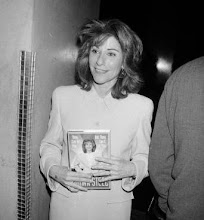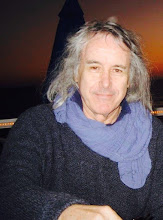
"The show blew me away." Adrian Lyne, director Fatal Attraction, Unfaithful
"I've never seen anything like it. I was spellbound." Ron Koslov, creator Beauty and the Beast
"Mr. Brando would like to obtain a copy of the show (Interview) he saw on television last night." Aiko, secretary to Marlon Brando
"I don't understand why there was an actor's credit at the end of the show, I thought it was real." Christopher Penn, actor Pale Rider
"Methinks he has talent." Bob Rafelson, director Five Easy Pieces, The Postman Always Rings Twice
"Whoever did this deserves an Academy Award." Ron Shelton, director Bull Durham, White Men Can't Jump
.
.
"I saw the most amazing show (Interview) on television." Ryan O'Neal, actor
"These TV guests are interviewer's dream." David Gritten, TV critic, Los Angeles Herald-Examiner
"I still can't believe these interviews aren't real." Wayne Satz, ABC News
..
An Evaluation of a Product-Integrated Concept
By
Stephen Mitchell
..
In September of 1985, I sat down in the studio to tape a television show that was unlike anything I'd ever done before. It was to be called "(Interview)" and I would ultimately tape 500 half-hour segments of this show, which was similar in tone to the Charlie Rose series currently on PBS. I conceived the form and function of the show with a specific purpose in mind. I wanted to sell a product that nobody wanted to a public that had an aversion to buying.
It was important to me that the show, which was actually a 28-minute commercial, be perceived as entertainment and not as a product pitch. Furthermore, it was imperative that, in purchasing the product, the buyer was made to feel part of a select group of cognoscenti.
The product to be marketed: stories for motion picture development. The public: film directors and producers. It is well established that, while scripts are difficult enough to sell to Hollywood, unpublished stories are impossible. The buying public of producers and directors unanimously refuse to accept unsolicited materials. The function of (Interview) was to create a demand for an unwanted product amongst an insolated public. It did exactly that.
Every design aspect of the show was premeditated to distill and manipulate the audience. Every show in the series featured a cast of two, an interviewer and an author. The guest had lived some incredible adventure that was recounted in his or her book. I played the interviewer. An actor played the author, for there was no book. What he or she would recount for the camera was actually a story of my own creation, but told as though it were their true story. Why an author with a book? My research told me that new books were the hot button with producers and directors. I called it "(Interview)".
Since the show would run on an obscure cable channel without promotion of any kind, I designed the show visually to capture my intended audience. Knowing that the majority of producers and directors are male with a tendency to channel-surf, I shot most of the show in an extreme close-up on the "author". The reason for this was that viewers are accustomed to seeing master, medium or two-shots and I knew that the extreme close-up, with its connotation of importance, would be visually arresting to the channel-surfer. I only occasionally used a wider close-up and a medium shot of the "author" to create a rhythm.
As the interviewer, I posed my questions from off-camera so that the viewing audience never saw me. This was another premeditated design decision. I needed a device to hold the viewer long enough for them to become interested in the story. I anticipated that viewers would be curious about who the interviewer was and would wait until they saw him before turning to another channel. I reasoned that by the time they realized that they wouldn't be seeing him, they would be hooked on the story. Were they ever!
From September 1985 to early 2001, 500 half-hour segments were produced. (Interview) resulted in regular sales of story ideas to film production companies, producer and directors. The series generated a "first-look” deal with Tri-Star Pictures, who would pay to see segments of (Interview) before it aired on cable television.
Elliott Ovitz (Interview) is one of the shows I did with G. Larry Butler who was a fixture in my repertory company for film & TV appearing in many of our shows and movies. Recently he made digital copies from his VHS copies and what you see here are excerpts from a segment that was 28 minutes long.
Each week, the (Interview) presented a fictional interview with an 'author' who has written about an extraordinary event in his or her life. The interview was presented as real except that the end credits reveal that an actor has played the role of the fictional author. I did 500 of these segments from over a twenty year period and fans included Marlon Brando, Adrian Lyne, Ron Shelton, T-Bone Burnett, Angie Dickinson, Lou Moreheim, David Permut and many others...
Elliott Ovitz (Interview) is one of the shows I did with G. Larry Butler who was a fixture in my repertory company for film & TV appearing in many of our shows and movies. Recently he made digital copies from his VHS copies and what you see here are excerpts from a segment that was 28 minutes long.
Each week, the (Interview) presented a fictional interview with an 'author' who has written about an extraordinary event in his or her life. The interview was presented as real except that the end credits reveal that an actor has played the role of the fictional author. I did 500 of these segments from over a twenty year period and fans included Marlon Brando, Adrian Lyne, Ron Shelton, T-Bone Burnett, Angie Dickinson, Lou Moreheim, David Permut and many others...
..
The show enjoyed a fan base of producers, directors and creative artists including those listed here:
Tamara Asseyev, producer
Marlon Brando, actor
T-Bone Burnett, music producer
Sammy Cahn, lyricist, 4 Oscars
Robert Colton, producer
Angie Dickinson, actress
Stan Dragoti, director
Larry DuBois, literary editor
Charles Eastman, director
Charlie Evans, Jr., producer
David Felson, producer
John Flynn, director
Sean Furst, producer
Alan Garfield, actor
Alex Grasshof, producer
David Gritton, TV critic
Shelly Hack, actress
Alan Hamel, manager
Henry Jaglom, director
Steven Keats, actor
Carroll Kemp, producer
Ron Koslow, writer, producer
Tom Laughlin, director, producer
June Lockhart, actress
Adrian Lyne, director
Lou Moreheim, producer
Ryan O'Neal, actor
D. W. Owen, producer
Christopher Penn, actor
David Permut, producer
Bob Rafelson, director
Al Ramus, writer
John Rappaport, journalist
Wayne Satz, KABC news
 One day I received a phone call from someone at the Los Angeles Herald-Examiner, a Hearst newspaper in competition with the Times. They asked if they could send someone to interview me about my series (Interview) which had come to their attention. Of course, I agreed. Arrangements were made and the Herald's television critic David Gritten arrived at my house in Laurel Canyon along with a photographer.
One day I received a phone call from someone at the Los Angeles Herald-Examiner, a Hearst newspaper in competition with the Times. They asked if they could send someone to interview me about my series (Interview) which had come to their attention. Of course, I agreed. Arrangements were made and the Herald's television critic David Gritten arrived at my house in Laurel Canyon along with a photographer.The Herald-Examiner was my favorite newspaper at the time featuring columns over the years from Bud Furillo, Melvin Durslag, Alan Malamud and Doug Krikorian--an All-Star line-up if ever there was one! Though I'd read the Style section, which was devoted to the arts, I was unfamiliar with David Gritten so I looked for his articles to see what he wrote. I wished I hadn't. The first article I came across was a piece he did on a media personality who was promoting her film career based on a personal relationship with a male box office star. David dissected her with surgical precision usually reserved for autopsy procedures implying, perhaps, that her career was dead. I was forewarned.
As David conducted the interview in my living-room, I had no idea of his personal reaction to what I was saying in response to his questions. His British reserve and equanimity served him well and left me to focus on his questions rather than his thoughts. Later, we went out onto the deck overlooking the canyon where we took the photo that accompanies the article. As David and the photographer left, I had no idea whether he liked (Interview) or intended to write its obituary. I would have to wait to find out.
A few days later, I received a call telling me the article would appear in the Sunday edition and so it did. It was on the front page of the Style section with two other articles--one about Bernardo Bertolucci receiving the Oscar for The Last Emperor and the other about the Getty Museum. At least I was in good company!
Reading the article, it immediately became clear that David liked (Interview) opening with, "Los Angeles devotees of superior TV talk shows have been keeping a closely guarded secret to themselves these last couple of years." He wrote a very complimentary and appreciative appraisal of the series and David was not someone to hand out idle compliments in print.
I had been intrigued by David's "poker face" during the interview betraying none of his reactions and, given what he had written about the show, I decided to invite him to play an author in front of my cameras. Happily, he accepted. We went into the studio where I created a persona and story for him in the few minutes before we taped. He would be a British spy and there would be some professionally and personally controversial issues in the story. He gave a great performance.
Days later, after I had delivered a copy of his episode on cassette to him, David called me. He said that, while watching his performance in the interview, he couldn't tell where his truth ended and my fiction began. It was, perhaps, the best compliment he could have paid to me.










